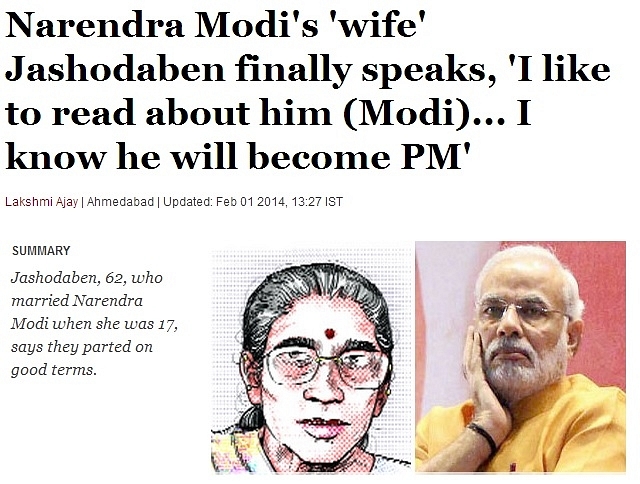
The Real Abusers of Jasodaben
Indian Express interviewed Narendra Modi’s “wife” Jasodaben recently. As the interviewer stated, the lady “who married Narendra Modi when she was 17, says they parted on good terms”, over 40 years ago. From the interview, it is evident that after an amicable separation, the lady went on to lead an independent, single life, and bore no grudges. She is clearly a Modi supporter and wishes him success. In fact, she states “I know he will be PM one day!” Yet, sections of the media have suddenly appointed themselves her champions, and are busy trying to teach Modi moral science lessons. Here is a set of tweets by the man who set this distasteful discourse rolling:
Hartosh Singh Bal is journalist and a frequent Modi baiter:
The legal case
It would appear that Hartosh Bal’s visceral dislike of Modi has made him shun the basic journalistic principle of due diligence .If he has done his homework, he would know that the Indian law prohibits marriage for women younger than 18 and men under the age of 21. Here are definitions from The Prohibition of Child Marriage Act, 2006
that he would do well to brush up on:
(a) “Child” means a person who, if a male, has not completed twenty-one years of age, and if a female, has not completed eighteen years of age;
(b) “Child marriage” means a marriage to which either of the contracting parties is a child;
(c) “Contracting party”, in relation to a marriage, means either of the parties whose marriage is or is about to be thereby solemnized;
The Prohibition of Child Marriage Act, 2006 is an amendment of The Child Marriage Restraint Act of 1929 (Sarada Act), to overcome the shortcomings of the older act.
Despite legislation, child marriage continues to be problem in India. According to UNICEF, 18% of women are married by 15 years of age. With education and awareness, this practice is gradually dying out in the cities, but is still practiced in rural areas. Children are promised in marriage at a very young age, and the girl remains in her parents’ house till she reaches puberty. Then she is formally brought to the groom’s house for the marriage to be consummated.
However, such marriages can annulled (declared that it never existed), as per Section 12 of the Hindu marriage Act, 1955. Annulment can be initiated either by the man or the woman who has been forced into an underage marriage.
The moral case
Those who have chosen to highlight this case know that they have no legal ground. Hence they have slyly used the moral track. This is an example of how the narrative is being manipulated:
Sagarika Ghose is a deputy editor at CNN-IBN
The problem with these arguments is that they are shallow and intellectually dishonest. First of all, Ms Ghose and her ilk are selective and inconsistent. For example, when questions are asked about Sonia Gandhi’s treatment abroad, the same set indignantly claim that it is a private affair, even though there is no clarity on who is footing the bill and how. When a Congress Minister’s wife dies under tragic and mysterious circumstances, the case disappears from media glare, because it is a “private affair”. Yet, when an elderly lady is dragged out from her quiet life, and her life is dissected in public glare, the “right to privacy” is promptly thrown into the bin. Ms.Ghose salivates “on why Jasodaben couldn’t be a part of his life”. Why the double standards?
Even if we assume that certain sections of the population have special love for Modi, and that the minute scrutiny his private life is fundamental to India’s progress, the story still does not add up. Why is there so much concern for a lady after 46 years of an illegal marriage? Did she approach the media or the courts? Did she complain or ask for help? Did she claim that she wanted anything from Modi? The answer to those questions is a resounding NO! On the contrary, the lady educated herself – something a teenaged Modi had encouraged her to do – and carved out an independent life. She did not play victim or depend on the charity of a man. That by most definitions is real empowerment. What is being done to her now, in the guise of empowerment and concern, is abuse!
Finally, the champions of morality conveniently forget that if this is indeed a story of victimhood, there are two victims: the lady in question and Modi. Both were victims of child marriage, and circumstances beyond their control. Both had to suffer the consequences of decisions imposed by elders, which they were in no position to oppose.
The sad fact is that child marriage continues to be a problem in India. There is scope for debate on the ills of the practice. There are enough studies to show that this practice has a bearing on maternal deaths, poor infant health, and increased physical and sexual violence against women. There is also a need to highlight the plight of both genders involved in a forced marriage.
However, when so-called champions of women took up this particular case, it was not about child marriage at all. It was an excuse for mudslinging on Modi, under the guise of concern. To the depraved perpetrators of this charade, I say: If you must take part in titillating gossip, at least have the courage to do so openly. When you use the garb of women’s empowerment to effectively abuse another, you are no different from the patriarchal scum, who use and discard women at will.